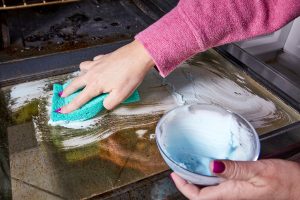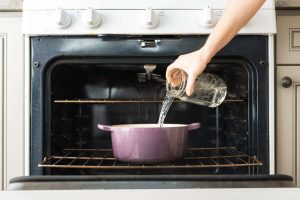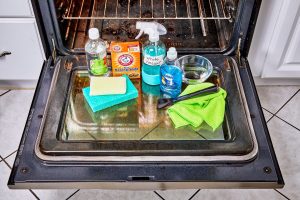Spring Cleaning is Here! Organize and Declutter Your Home Today.
Whether the oven is used frequently or occasionally, maintaining cleanliness can present a challenge. While quick clean-ups are helpful, periodic deep cleaning is recommended. Both commercial and homemade oven cleaners are available. This article reviews methods for cleaning ovens without chemical sprays. Regardless of the chosen method, it is advisable to begin by vacuuming out accumulated dirt, dust, crumbs, and debris. (Vacuuming after running the self-cleaning cycle is also suggested.) The vacuum hose can be used, or the crevice attachment may be preferred for more precision. If an upright vacuum is inconvenient or the kitchen space is limited, a handheld vacuum may be suitable. An old toothbrush can be effective for cleaning hard-to-reach areas and corners in the oven.
For this cleaning method, assemble the following items: baking soda, water, vinegar, a spray bottle, cleaning cloths, and a rubber spatula.
Prepare the paste: Mix ½ cup baking soda with sufficient water to form a paste. Spread the paste evenly throughout the oven interior, ensuring no contact with heating elements. Allow the paste to remain for at least two hours, or preferably overnight. Spray a mixture of equal parts white vinegar and water on stubborn stains to facilitate removal. After 30 minutes, eliminate any remaining residue and clean the interior surfaces with a damp cloth.
Lemon-based cleaning offers an alternative approach. Combine water and two lemons for effective oven cleaning. The procedure parallels steam cleaning with vinegar. Fill a pan with water and add the juice of two lemons along with the lemon halves. Place the pan in the oven at 250 degrees Fahrenheit. Once the water begins to boil, remove the pan; the resulting steam will loosen grime and grease. Once cooled, clean the oven using a damp cloth.
Another lemon cleaning technique involves direct scrubbing. Halve a lemon, coat the cut surface with baking soda, and use it to scrub away grease and dirt. The interaction between the lemon’s acidity and baking soda naturally removes tough stains.
Cleaning Oven Racks in the Bathtub: Due to their size and shape, oven racks often require specialized cleaning. Parry advocates soaking racks in the bathtub with the following steps. Protect the tub with old towels or blankets. Fill the tub with water and dissolve a dishwasher tablet. Place oven racks in the tub and allow them to soak for several hours or overnight. Use an old toothbrush or heavy-duty scrubber to remove any food residue. Remove racks, rinse thoroughly with warm water, and let dry.
Steam cleaning with hot water and vinegar will loosen up the grime. Bring 1/3 pot of water to a boil, then add an equal amount of white vinegar and continue boiling briefly. Transfer the pot to the oven, close the door, and let it sit for 45 to 60 minutes. Clean the oven interior with a soapy cloth; softened grime is readily removed.
Natural Cleaning Solution: A straightforward, eco-friendly option involves spraying the oven with a mix of equal parts white vinegar, dish soap, and water. Allow the solution to sit for several hours before wiping clean or scrubbing with a brush as needed. 
Knob Cleaning Procedures: For ovens and ranges with removable knobs, consider the following protocol. Most can be detached by gently pulling. Place the knobs in warm, soapy water for at least one hour to dislodge grease and debris without manual scrubbing.
Rinse the knobs, then lay them on a paper towel or kitchen towel until fully dry before reattaching.